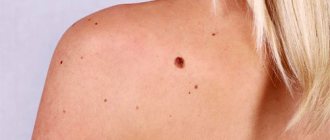Almost every person experiences warts, moles or papillomas during their lifetime. They often appear in places where they look unaesthetic, which makes them worry about their appearance. Moreover, not all of these skin defects are harmless. Therefore, the removal of benign skin tumors plays a very important role in dermatology.
Types of benign skin neoplasms
Benign skin tumors do not pose a serious threat to humans, but they cause psychological and even physical discomfort, especially when located in areas of the body that are not usually covered by clothing. The main benign neoplasms include:
- Warts and papillomas. Occur on the skin due to infection with the human papillomavirus (HPV). They are painless and are small growths with a height and a diameter of several millimeters. These neoplasms are localized in the folds of the skin, have blood vessels and a loose structure, and can change color and grow.
- Nevi (moles). They are based on melanocytes - cells that contain the main coloring pigment of the body. Most moles are harmless, especially if they are small and do not cause discomfort, that is, they are not located on open areas of the body.
Vulgar warts
They form on the face and hands in both children and adults.
They are also called common or simple warts.
Morphological elements have the appearance of papules.
They can have different sizes.
Sometimes these are small warts on the face, the diameter of which does not exceed 1-2 mm.
There are also larger sizes – up to 1 cm.
In immunodeficiency states, they can grow to impressive sizes.
Upon inspection, it is noticeable that the surface layer of the element is covered with cracks.
Hyperkeratosis is observed on it.
That is, a layer of dead cells.
As a result, simple warts have a hard surface.
As a rule, they do not differ in color from the surrounding skin.
Although in some cases these may be red warts on the face.
At their location, the skin pattern is lost.
However, when the formation disappears, the relief of the epidermis is restored.
If a doctor examines a formation on the face under a magnifying glass, the warts are covered with black or brown dots.
They are capillaries (small blood vessels) that are blocked by blood clots.
This symptom is pathognomonic.
That is, it occurs only in warts.
Detection of this symptom makes it possible to differentiate them from other skin formations.
For example, from keratomas or skin tumors.
As a rule, small warts on the face are round in shape.
If they reach large sizes, they can acquire a polycyclic form.
More often, warts are single.
Less often they are located in groups of several pieces.
At the same time, no systematicity is observed.
The arrangement of the morphological elements of the skin is chaotic and asymmetrical.
If a wart on the face is removed poorly, new formations may appear in the same area.
They are located around the therapeutic area.
Why and when do you need to remove skin tumors?
If there are suspicious neoplasms, it is better to consult a dermatologist. This is necessary if the defect grows, their number increases, a dark spot forms around, and the growth itself itches and hurts. The decision to remove tumors is made by a dermatologist based on the diagnosis and patient complaints. The type of growth, its characteristics and the likelihood of malignant degeneration are taken into account.
Removal of tumors on the face or other parts of the body is required in the following cases:
- They are located in those areas of the body where they are constantly exposed to friction and have a high risk of damage. These are the areas of the armpits, groin, and inner thighs that are regularly shaved.
- There is a high risk of degeneration. This applies to situations where the growths were accidentally damaged.
- Unaesthetic type of neoplasm. More often this is due to the fact that the mole or papilloma is in a visible place, which causes psychological discomfort to the person.
Lots of warts
Sometimes a person develops a large number of warts on his face.
The reasons for this may be a disease called epidermodysplasia verruciformis.
Rashes appear that look like flat warts.
Most often they are quite large.
Arranged in groups.
The total number of warts is large.
They often merge with each other.
In appearance, such rashes can sometimes be confused with senile warts or solar keratosis.
Unlike many other types of warts, these pose a real threat to life.
Because they can develop into squamous cell carcinoma.
It is not always diagnosed in the early stages.
Considering that a large number of warts appear, it is very difficult to notice that any of them has changed shape or outline.
First, cancer develops locally.
Over time it can become invasive.
The color of such formations can be black or brown.
Hypopigmentation is less common.
In this case, the warts on the face turn white.
They have either a round or oval shape.
Sometimes warts reach large sizes and merge, forming a “geographic map”.
It is on the face that these formations most often transform into a malignant tumor.
Although they can also be located on the body and limbs.
Like simple warts, epithelial dysplasia is localized in areas of scratching and scratching.
An effective and safe method for removing skin tumors
The PsorMak clinic offers the safest and most painless removal of tumors using the radio wave method. The procedure is carried out using a special device “Surgitron”. It is based on an electrode that emits radio waves that are directed at the defect itself. Radio wave removal of skin tumors using the Surgitron device is effective and safe for several reasons, or rather, due to the advantages of the method.
Advantages of Surgitron over laser and other types of surgery:
- Non-contact and non-traumatic.
The flow of radio waves acts on the surgical area from a short distance, without damaging the groups of cells and nerve endings adjacent to this area. - Quick removal of skin lesions
without significant pain. - Very high cosmetic effect
, no scars. - It is easy to adjust and control the area
and depth of exposure, which is difficult with laser surgery.
The radio wave method at the Institute of Healthy Skin removes papillomas, moles, warts, keratomas, hemangiomas, and molluscum contagiosum.
Why and when do you need to remove skin tumors?
It is better to get rid of benign formations in the following cases:
- If they are located in areas of the body that are often subject to friction and other chronic trauma (for example, when shaving). These are the armpits, groin area, inner thighs, head, etc.;
- If formations have an increased risk of becoming malignant. For example, injured moles;
- For cosmetic purposes, if the formation on an open area of the body does not look very aesthetically pleasing.
After removing the changed area of skin, it is sent for a special study to confirm the diagnosis and exclude the presence of a malignant process.
Prices for services for the removal of skin tumors at the PsorMak clinic:
№ | NAME OF SERVICE | PRICE |
| 1 | Initial appointment with a dermatologist using a dermatoscope | 3400 2300 rub. |
| 2 | Removal of papillomas, condylomas, molluscum contagiosum | from 600 rub. |
| 3 | Removing viral warts | from 1250 rub. |
| 4 | Plantar wart removal | 3500 rub. |
| 5 | Removal of seborrheic keratomas, hemangiomas | from 1100 rub. |
| 6 | Removal of benign facial skin tumors | from 1800 rub. |
| 7 | Removal of benign facial skin tumors | from 1400 rub. |
The procedure is carried out by highly qualified dermatologists and, on average, takes about 20 minutes, local anesthesia is performed. The method has virtually no contraindications; however, to clarify the diagnosis and prescribe the procedure, a consultation with a dermatologist is necessary.
At the Institute of Healthy Skin, tumor removal is carried out by:
Gribanov Nikita Valerievich
Dermatovenerologist
Do benign formations hide the danger?
Benign neoplasms are unpredictable structures that can manifest themselves at any time or not at all. The process of their transformation into malignant ones has not been fully studied. There is no clear answer to the question of what exactly activates this process. It is believed that mechanical trauma, excess ultraviolet radiation, metabolic disorders and other factors contribute to degeneration. One way or another, if you have a benign skin lesion, you should not experiment and rely on chance. Moreover, today removal does not cause difficulties.
HOW TO MAKE AN APPOINTMENT at the PsorMak Institute for Healthy Skin
1. Click the button you see below -
Make an appointment
2. Fill in the fields in the form that appears. Be sure to check the correct phone number so that our specialist can reach you. After filling out, click on the “Submit” button.
3. Wait for our specialist to call. He will answer any of your questions and agree on the date and time of your visit to PsorMak.
The initial appointment includes:
- Visual examination , which will allow the specialist to get a general understanding of the condition of your skin and the pathology itself.
- Collecting anamnesis - finding out information about the development of the disease, living conditions, previous diseases, operations, injuries, chronic pathologies, allergic reactions, heredity, etc. Together with a general examination, this allows you to make a fairly accurate diagnosis and choose a method of treatment and/or prevention.
Make an initial appointment
Removal of warts using the radio wave method
This is the most gentle technique and is also best suited for small warts. High-frequency waves make it possible to remove pathological tissues by literally evaporating them, which makes this method similar to laser destruction. The mark left on the skin is practically invisible, so the use of radio waves is possible even on the face.
The advantages of this method also include:
- Painless;
- Fast recovery;
- Minimum complications and side effects;
- Elimination of bacteria during the procedure;
- No need for complex care;
- Possibility of histological analysis.
The downside is that radio wave surgery is not suitable for particularly large warts.
Removing warts with liquid nitrogen
Cryodestruction is a contact method for removing warts. Its advantages are its low price, speed of procedure, and good results. The method is suitable for removal in any area of the body, but is rarely used when working with the face - small marks are possible. On the negative side: sometimes there is pain during and after the procedure.
The removal process with liquid nitrogen is simple. The patient is placed or seated on a couch in the operating room, and the site of exposure is treated with an antiseptic. The doctor dips a cotton swab or special instrument into liquid nitrogen. Its temperature is below −195.75°C. After this, the doctor brings the stick to the wart and touches it. Tissues quickly freeze and collapse - cells rupture due to the expansion of frozen water. Remaining tissue is removed and the wound is treated.
Causes
A bone process on a vertebra appears for the following reasons:
- Infectious diseases of the spine and joints. These include osteoarthritis, facet joint arthrosis and arthritis.
Remember: Men feel the symptoms of arthritis earlier, but women suffer more from pain caused by osteophyte.
- Incorrect posture. Increased load on the spine leads to the formation of osteophytes.
- Metabolic problems. Poor nutrition, excess weight, problems with blood circulation - this leads to a deterioration in metabolism.
- Physical exercise. If the spine cannot cope with heavy weight, it becomes deformed and osteophytes appear.
- Spinal injury. It occurs due to bruises, dislocations, fractures, falls from a height onto the back.
Osteophyte is a terrible disease that appears suddenly
- Patient's age. Osteophytes often appear in older people. At the age of 60-70 years, the degenerative effect on the peripheral nervous system increases. In addition, by this age, bone tissue becomes vulnerable to destruction and quickly “wears out” without having time to recover.
- Genetic inheritance. Osteophyte can occur due to congenital defects and genetic defects. This type of spondylosis is more difficult to cure than that acquired over time.
- Inflammation of bone or other tissue near the spine. The inflamed tissue does not function fully and may even degrade. This leads to accelerated development of spondylosis.
- Sedentary work. In this position, the muscles relax greatly and cannot withstand the weight that presses on the spine. The disc is deformed, the amount of lime on the ligaments increases. Over time, bone growths appear from this lime.
Massage chairs
How to detect
Before starting treatment, you need to go to the clinic and consult a doctor. He will conduct the necessary examinations on site to assess the presence of reflexes and the patient’s condition. However, by palpation it will only reveal already expanded osteophytes. Small growths, but in the process of growth, are detected during other stages of the examination.
A. Radiography
Radiography is used to diagnose various pathologies of internal organs and the spine. X-rays penetrate dense opaque media and are absorbed by them to varying degrees, resulting in an image that reflects the state of the imaged area.











